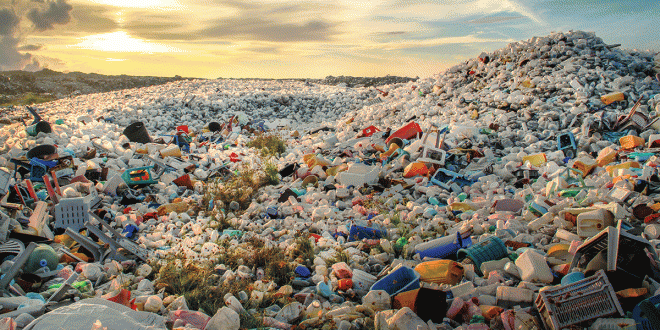PRIME Minister Justin Trudeau on Monday announced the Government of Canada is taking two additional steps to reduce Canada’s plastic waste, support innovation and promote the use of affordable and safe alternatives.
The government says it is committing to:
- ban harmful single-use plastics as early as 2021 (e.g., plastic bags, straws, cutlery, plates and stir sticks) where supported by scientific evidence and warranted, and take other steps under the Canadian Environmental Protection Act (CEPA) to reduce pollution from plastic products and packaging; and
- work with provinces and territories to ensure companies – such as large food retailers and product manufacturers – pay the full cost of collecting and recycling their plastic waste, through a system known as Extended Producer Responsibility. The goal is to fully transfer recycling costs from municipalities to companies that generate plastic waste in the first place, while reducing the amount of plastic waste in the environment.
These measures will be grounded in scientific evidence and will align where appropriate with similar actions in the EU or other leading countries. These steps will also support the Canadian Council of Ministers of the Environment’s development of an action plan to implement the Canada-wide Strategy on Zero Plastic Waste.
Trudeau said: “As Canadians, we tie our national identity and pride to the beauty of our nature, the waters of our rivers, our lakes, and the oceans that surround us. We have a responsibility to protect what defines us and to take action to make our economy stronger. By reducing plastic waste and supporting new innovative technologies, we will create economic growth that benefits everyone, and leave a better, healthier planet for future generations.”
The government noted that plastic pollution is a global challenge that requires immediate action. Plastic waste ends up in our landfills and incinerators, litters our parks and beaches, and pollutes our rivers, lakes, and oceans—entangling and killing turtles, fish and marine mammals.
And a recent study commissioned by the Government of Canada found that less than 10 per cent of plastic used in Canada today gets recycled. Without a change in course, it’s estimated that Canadians would be throwing away $11 billion worth of plastic materials each year by 2030. We have reached a defining moment—if we do not act now, plastics could outweigh fish in our oceans by 2050.
With the longest coastline in the world and one-quarter of the world’s freshwater, Canada recognized that we have a unique responsibility—and opportunity—to lead in reducing plastic pollution. Through the Ocean Plastics Charter, launched by Canada at the G7 in Charlevoix last year, Canada and more than 20 governments and 60 organizations and businesses have set a target of making all plastics recyclable or reusable (or where not possible, to make them recoverable) by 2030. Signatories to the Charter have also agreed to reduce single-use plastics and promote the use of recycled plastics.
Catherine McKenna, Minister of Environment and Climate Change, said: “We’ve all seen the disturbing images of fish, sea turtles, whales and other wildlife being injured or dying because of plastic garbage in our oceans. Canadians expect us to act. That’s why our government intends to ban harmful single-use plastic products where science warrants it, and why we’re working with partners across Canada and around the world to reduce plastic pollution. Taking these steps will help to create tens of thousands of middle-class jobs and make our economy stronger—while protecting fish, whales and other wildlife, and preserving the places we love.”
Jonathan Wilkinson, Minister of Fisheries, Oceans and the Canadian Coast Guard, added: “We know plastic pollution harms Canada’s oceans, wildlife, communities—and our economy. It’s a problem we simply can’t afford to ignore. That’s why we’re taking action to stop plastic from polluting the environment in the first place, and to clean it up once it’s there. It’s time to stop seeing plastic as garbage, and instead look at ways we can capture its economic value and protect our land and coasts at the same time.”
Quick Facts
- Every year, Canadians throw away over 3 million tonnes of plastic waste. This represents up to $8 billion per year in lost value and wastes valuable resources and energy.
- About one-third of the plastics used in Canada are for single-use or short-lived products and packaging. In fact, in Canada, up to 15 billion plastic bags are used every year and close to 57 million straws are used daily.
- Fixing how Canada’s plastic waste is managed and investing in innovative solutions would reduce 1.8 million tonnes of carbon pollution, generate billions of dollars in revenue, and create approximately 42,000 jobs—all while keeping plastic out of our landfills and oceans, and protecting the places Canadians love.
- To lead by example, the Government of Canada has committed to divert at least 75 per cent of plastic waste from federal operations by 2030, by purchasing more sustainable products and eliminating unnecessary single-use plastics in meetings, events and government facilities. Canada is also investing $10 million to develop innovative Canadian solutions to reduce plastic waste, and launching a new Plastics Science Agenda to accelerate research on the lifecycle of plastics and identify evidence-based solutions to meet Canada’s goal of reducing the amount of waste Canadians throw out by 30% per person by 2030 and 50% by 2040, relative to 2014.
- Every year, 640,000 tons of abandoned, lost or discarded fishing gear (or ghost gear) enters our oceans. Ghost gear can persist in the environment for up to 600 years.
- Internationally, Canada is investing $100 million to address plastic waste management in developing countries including $65 million through the World Bank, $6 million to strengthen innovative private-public partnerships through the World Economic Forum’s Global Plastic Action Partnership and $20 million to help implement the G7 Innovation Challenge to Address Marine Plastic Litter.
- Each year, one million birds and over 100,000 sea mammals worldwide are injured or die when they mistake plastic for food or become entangled.
- Globally, one garbage truckload of plastic waste enters the ocean every minute, and that amount is increasing steadily.
- To reduce the amount of plastic microbeads entering Canadian freshwater and marine ecosystems, Canada prohibited the manufacture and import of all toiletries that contain plastic microbeads (such as bath and body products) as of July 1, 2018. A complete ban comes into force July 1, 2019.
- Over the last 25 years, nearly 800,000 volunteers have removed over 1.3 million kilograms of trash from across Canada’s shorelines through Ocean Wise and World Wildlife Fund’s Great Canadian Shoreline Cleanup program, supported by the Government of Canada. The most commonly littered items on our shorelines are single-use or short-lived products, many made of plastics.
Canada is also supporting global efforts to reduce plastic pollution, with a $100 million investment to improve waste management in developing countries
 Desi Today Magazine
Desi Today Magazine




